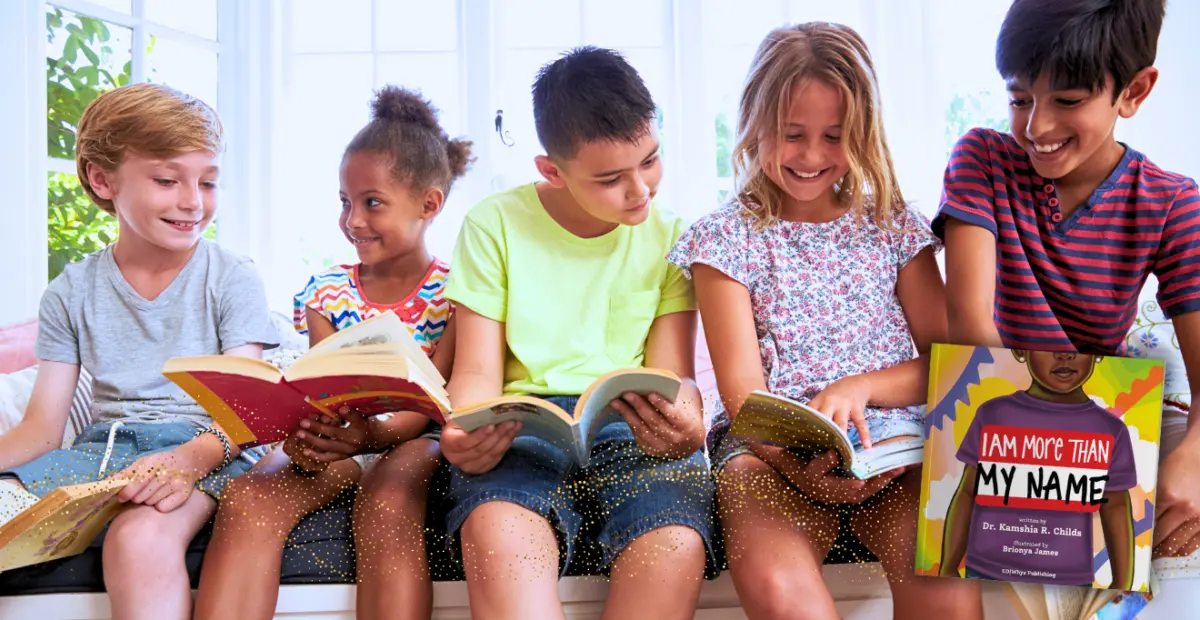Key Elements to Literacy Learning That Make a Difference
Literacy Leaders in PreK-5 — you’re in for an inspiring read! Learn the key elements to literacy learning from Dr. Kamshia Childs, and how personal experiences can transform reading and writing for young learners.
The Latest in Literacy blog is honored to feature guest author Dr. Kamshia Childs, a passionate education advocate.
Not only is Dr. Childs a literacy professor, educator, and published children’s book author, she’s also a member of our Kids Read Now Board.
Dr. Childs’ insights align perfectly with Kids Read Now’s mission to foster a love of reading through personalized, meaningful literacy experiences that empower every child.
In the article below, she highlights key elements to literacy learning that can help Literacy Leaders like you create more meaningful, personalized experiences for their students.
The power of a name in personalized literacy learning
I am a former first-generation college student, former public school elementary teacher, turned literacy professor and teacher educator, and I recently published my first children’s book, “I Am More Than My Name” (EdWhys Publishing).
It is a poetic tribute to owning the power of having a unique name, despite challenges that something as simple as a name might present.
It is a personal story to me, as my name is not spelled phonetically — and it has been a challenge to get people to understand and accept that a name represents so much more than a label or a title that people give you. It’s attached to stereotypes, and it can be attached to confidence or lack of.
Taking a concept as simple as a name, writing a poem, and creating a book that captures the emotions I have when someone pronounces it wrong, has allowed me to go through the same reading and writing processes that I have long taught my own students of various ages.
Free Teacher & Parent Pack!
Boost their desire to read: two packs with three game templates created by literacy experts sure to tempt students of all reading levels to pick up a book and begin reading!
Key elements to literacy learning: What makes it personal?
As a teacher and now a published children’s book author, I have found that literacy learning experiences are unique to each learner and should be personal.
Let’s explore “P.E.R.S.O.N.A.L.” in an acrostic or acronym format…
P — Personalization
What works for one literacy learner might not work for another. Educators and parents need to provide variety and choices in texts, resources, and activities.
E — Engagement
Students are engaged in stories and texts that are a reflection of their worlds — inside and outside of the classroom.
R — Relevance
There is often a disconnect between what students value outside of their academic setting, and what is inside the academic setting. Literacy learning becomes relevant if students can take what they are learning and apply the skills to what they are engaged with.
S — Sharing and publishing
Publishing work is the final step in writing, and students often miss this opportunity.
Having students write and reflect on their reading experiences, and getting opportunities to publish their reflections about their reading, is very important.
Students need to know that readers are listening to someone’s voice, and through writing they are sharing their voice.
O — Opportunities to discuss books and text
Having discussions about reading isn’t just a classroom task.
Students need opportunities and ideas as to how to discuss texts they encounter (for traditional and non-traditional texts).
N — Narratives
Students need to be exposed to texts with narration (like plays and scripts) as well as texts with narrative features (such as dialogue, plot, setting, characters, etc.).
A — Authentic texts
Students often love reading fiction, but they also need texts that share real-world scenarios and are used in the real world. They also need texts that use environmental print, articles, clips, blogs, photos, etc.
L — Language learning through texts
Students need opportunities to develop and explore vocabulary and language through reading and writing. This should include academic and social/cognitive language.
Get distracted students refocused and learning
Reignite learning. Sign up to get 10 quickfire academic activities that combine learning with fun. Quick and easy to weave into any lesson.
The literacy journey matters more than the destination
Teaching and learning have always been “P.E.R.S.O.N.A.L.” for me.
Publishing my work through my first children’s book was a long, tedious, and vulnerable process that I shared with my students and colleagues at various points along the way.
I had the opportunity to “practice what I preached” and go through the process that I have for so long taught others. My writing is traveling around the country — and world — in places that I never thought it would.
Our students (young and old) need to know that reading and writing is a unique process that empowers and inspires.
Key elements of literacy learning in your classroom
Consider how Dr. Childs’ “P.E.R.S.O.N.A.L.” framework can support your students:
- How are you personalizing literacy for different learners?
- Are students engaged with texts that reflect their lives?
- Are there authentic opportunities for students to share, discuss, and publish their work?
Ready to personalize literacy learning for your students?
Next steps for Literacy Leaders:
- Explore personalized literacy strategies with Kids Read Now.
- Check out our Wish List for diverse, engaging books.
- Use our Discover More resources to support comprehension and student engagement.
Pro Tip: Look for books with this symbol to read about the experiences of multiethnic characters:
About the Author
Dr. Kamshia Childs is a literacy professor, author, advocate and mentor to future and current educators.
Dr. Childs has taught in public schools and universities in Kansas and Texas for over twenty years. She has served in various capacities as a tutor and paraprofessional in the K-6 setting, and she has been a teacher in grade levels 4-6. Dr. Childs has taught all subjects, but her specialty area is English Language Arts and Reading.
She holds an Ed.D. in Curriculum and Instruction, M.S. in Curriculum and Instruction (Reading and Language Arts), and a B.S. in Elementary Education (ESL). As a current faculty member at Texas A&M University-Commerce, she teaches literacy courses to pre-service teachers and completes site visits into schools, serving urban, rural, and suburban populations in the Dallas/Fort Worth Metroplex.
Working in an ESL setting has allowed her to have exposure to a variety of ethnic backgrounds and experience with students that have spoken over twelve different languages throughout her career. Dr. Childs takes pride in making learning relevant and meaningful for students.
In addition to the children’s book I Am More Than My Name, Dr. Childs has published numerous literacy and multicultural education articles in peer-reviewed journals and contributed to book chapters. She is a National Writing Project site Co-Founder and presents at various state, national, and international conferences on topics related to literacy, educator empowerment, parent involvement, and culturally relevant pedagogy.
To learn more about Dr. Childs, visit her on most social media platforms at @Doctorkchilds or visit her website at drkchilds.com.
Break barriers in your literacy progress
Discover the program that transforms reading habits and elevates district-wide literacy outcomes.
Challenge what's possible. Explore with us.
Frequently Asked Questions
What are the key elements to literacy learning?
The key elements to literacy learning are outlined in Dr. Kamshia Childs’s “P.E.R.S.O.N.A.L.” framework, which stands for Personalization, Engagement, Relevance, Sharing and Publishing, Opportunities to Discuss Texts, Narratives, Authentic Texts, and Language Learning Through Texts.
<strong>How can Literacy Leaders implement the key elements to literacy learning in their classrooms?</strong>
Literacy Leaders can apply Dr. Childs’s “P.E.R.S.O.N.A.L.” framework by incorporating diverse, authentic texts, encouraging student voice through writing and publishing, creating engaging discussions, and tailoring literacy activities to meet the unique needs of each learner.
<strong>What does “authentic texts” mean in literacy instruction?</strong>
Authentic texts are real-world materials such as articles, blogs, environmental print, and multimedia content. They help students see the relevance of reading and writing beyond the classroom.
How can educators create opportunities for students to discuss books and texts?
Educators can facilitate book clubs, reading circles, peer discussions, and informal conversations that encourage students to share their thoughts, make connections, and develop critical thinking skills.
How can teachers personalize literacy learning for their students?
Teachers can personalize literacy learning by offering diverse texts, resources, and activities that reflect students’ interests, cultural backgrounds, and learning styles, ensuring that each student feels seen and engaged.



